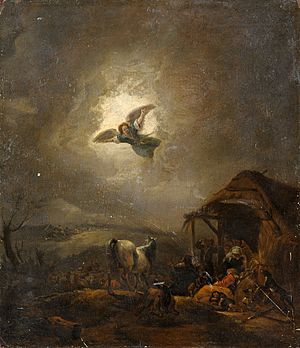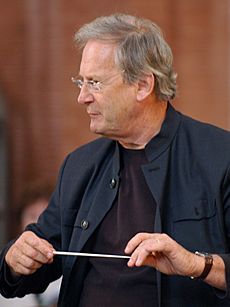Unser Mund sei voll Lachens, BWV 110 facts for kids
Quick facts for kids Unser Mund sei voll Lachens |
|
|---|---|
|
|

Angels Appearing to Shepherds, a painting from the 17th century. This scene is part of the Christmas story.
|
|
| Related |
|
| Occasion | First Day of Christmas |
| Performed | 25 December 1725: Leipzig |
| Movements | 7 |
| Vocal | SATB choir and solo |
| Instrumental |
|
Unser Mund sei voll Lachens (which means "May our mouth be full of laughter"), also known as BWV 110, is a special kind of musical piece called a church cantata. It was written by the famous composer Johann Sebastian Bach. He created this Christmas cantata in Leipzig, Germany, especially for Christmas Day. It was first performed on December 25, 1725.
Bach composed this cantata during his third year as the Thomaskantor (music director) in Leipzig. He used words written by Georg Christian Lehms, which were published many years earlier in 1711. The words for this cantata are a bit different from some of Bach's other works. Instead of just having songs (arias) and spoken parts (recitatives), it includes three parts taken directly from the Bible. These include verses from Psalm 126, a verse from the Book of Jeremiah about God's greatness, and the angels' song from the Christmas story in the Gospel of Luke. The final song, called a chorale, comes from a hymn by Caspar Füger called "Wir Christenleut."
Bach wrote the music for four singers (soloists), a four-part choir, and a Baroque orchestra. This orchestra included trumpets and timpani (drums), transverse flutes, different types of oboes, string instruments (like violins and violas), and a basso continuo (a group of instruments that play the bass line and harmonies), which included a bassoon. The first big song, called a chorus, sounds like a French overture. Bach actually used music from his fourth Orchestral Suite for this part, adding voices into its fast middle section. The angels' song in the cantata is based on a Christmas part from his Magnificat in E-flat major, BWV 243a. Bach carefully chose which instruments would play with each solo song to show different feelings. For example, two flutes played with the tenor singer to show the "lowly birth" of Jesus. An oboe d'amore played with the alto singer to represent God's love. Trumpets, oboes, and strings played with the bass singer for a joyful call to sing. Bach himself led the Thomanerchor (a famous boys' choir) for the first performances on Christmas Day. They performed once in the Nikolaikirche and again in the Thomaskirche.
The Story Behind the Music
Bach wrote this cantata in 1725 for Christmas Day, which was the first of three days of Christmas celebrations in Leipzig. For this special day, people would read certain Bible passages. These included parts from the Epistle of Titus about God's kindness, or from Isaiah about a child being born. They also read from the Gospel of Luke, which tells the story of Jesus' birth, the angels appearing to the shepherds, and the angels' song.
In 1723, his first year in Leipzig, Bach didn't write a new cantata for Christmas Day. Instead, he used an older one. But in 1724, he wrote three new cantatas, one for each Christmas feast day. For this cantata in 1725, Bach used words by Georg Christian Lehms. Lehms's text started with two verses from Psalm 126. These verses talk about the joy people felt when they returned to Jerusalem, saying, "When the Lord turned again the captivity of Zion, we were like them that dream." The text also included a verse from the Book of Jeremiah that praises God's greatness. And it quoted the angels' song from the Christmas story in the Gospel of Luke. This older style of text mixed Bible quotes with solo songs (arias). The cantata ends with the fifth verse of the hymn "Wir Christenleut" by Caspar Füger.
Bach led the first performance of the cantata with the Thomanerchor on Christmas morning in the Nikolaikirche. They performed it again that afternoon in the Thomaskirche. He also led at least one more performance of this cantata between 1728 and 1731.
For a while, some experts thought this cantata was written in 1734 to celebrate the end of a war. However, when the original text was found, it showed that the cantata was not about the war at all. This cantata was not published until 1876. That's when it appeared in the Bach Gesellschaft Ausgabe, which was the first complete collection of all of Bach's works.
What Instruments Are Used?
Bach organized this cantata into seven different parts, called movements. It starts with a big opening song for the choir and ends with a final hymn. In between, there are solo songs (arias), a spoken part (recitative), and a song for two singers (a duet).
Bach wrote the music for four solo singers: a soprano (high female voice), an alto (lower female voice or high male voice), a tenor (high male voice), and a bass (low male voice). He also wrote for a four-part choir and a Baroque orchestra. This orchestra included:
- Three trumpets and timpani (drums)
- Two transverse flutes
- Three oboes (including special types like the oboe d'amore and oboe da caccia)
- Two violins
- A viola
- And a basso continuo (which usually includes a bassoon and a keyboard instrument like a harpsichord or organ).
The original music sheets said: "Jesus help. First feast day of the birth of Christ. Concerto for 3 trumpets, timpani, 3 oboes, bassoon, 2 violins and viola, 4 voices and continuo." This piece usually lasts about 27 minutes.
Here's a simple look at the different parts of the cantata:
| No. | Title | Text | Type | Vocal | Winds | Strings | Key | Time |
|---|---|---|---|---|---|---|---|---|
| 1 | Unser Mund sei voll Lachens (May our mouth be full of laughter) | Psalm | Chorus (Big song for choir) | SATB | 3 Tr, Ti, 2 Ft, 3 Ob, Fg | 2 Vl, Va | D major | |
| 2 | Ihr Gedanken und ihr Sinnen (You thoughts and musings) | Lehms | Aria (Solo song) | T | 2 Ft, Fg | B minor | ||
| 3 | Dir, Herr, ist niemand gleich (There is no one like You, Lord) | Jeremiah | Recitative (Spoken-like part) | B | 2 Vl, Va | |||
| 4 | Ach Herr! was ist ein Menschenkind (Ah, Lord, what is a human being) | Lehms | Aria (Solo song) | A | Oa | F-sharp minor | 3/4 | |
| 5 | Ehre sei Gott in der Höhe (Glory to God in the highest) | Luke | Aria (Duet for two singers) | S T | A major | 12/8 | ||
| 6 | Wacht auf, ihr Adern und ihr Glieder (Awaken, veins and limbs) | Lehms | Aria (Solo song) | B | Tr, 2 Ob, Oc | 2 Vl, Va | D major | |
| 7 | Alleluja! Gelobt sei Gott (Alleluia! Praise be to God) | Füger | Chorale (Hymn-like song for choir) | SATB | Tr, 2 Ft, 2 Ob, Oc, Fg | 2 Vl, Va | B minor |
Exploring the Music's Parts
In 1725, Bach usually wrote cantatas with alternating spoken parts (recitatives) and solo songs (arias) based on new poems. But for this work, he used an older style of text that mixed Bible verses with solo songs. Bach followed this style, using different musical forms for the Bible quotes. The first big song, based on verses from a psalm, is actually an adapted version of the opening music from his fourth Orchestral Suite. The duet "Ehre sei Gott in der Höhe" (Glory to God in the highest) is based on a Christmas part called Virga Jesse floruit from Bach's Magnificat in E-flat major, BWV 243a, which he performed for his first Christmas in Leipzig in 1723.
The Opening Song

The cantata begins with a big chorus called "Unser Mund sei voll Lachens" (May our mouth be full of laughter). All the instruments play in this part. The words say that "the Lord has achieved great things for his people." Bach based this music on the opening of his fourth Orchestral Suite. He made it even more festive by adding trumpets and timpani, and also flutes. He also added the voices into the music. This part is like a French overture, which usually has slow instrumental sections around a fast middle section. French overtures were often played when a king arrived, so it was a fitting style to welcome the "King of Heaven." The "laughter" in the text is often heard clearly in the music, as if the instruments and voices are laughing. When Bach performed this piece again later, he marked some vocal parts as "ripieno" (meaning they should be played by a larger group), which added even more variety.
Solo Songs and Duets
- The second part is a solo song for the tenor singer, "Ihr Gedanken und ihr Sinnen" (You thoughts and musings). It is accompanied by two transverse flutes. Some experts believe the flutes were chosen to represent the humble (lowly) birth of Jesus.
- The third part is a spoken-like section for the bass singer, "Dir, Herr, ist niemand gleich" (There is no one like You, Lord). The string instruments play along, making upward-moving sounds that match the bass voice.
- The fourth part is a solo song for the alto singer, "Ach Herr, was ist ein Menschenkind" (Ah, Lord, what is a human being). It is accompanied by a solo oboe d'amore. This instrument helps express wonder about humans and God's interest in them. This song has two parts. It starts by talking about humans being sinful, but then changes to the idea of being saved. One expert, Klaus Hofmann, suggests that the oboe d'amore's sound helps answer the question "Why does God do all this for man?" with "Aus Liebe" (through love).
- The fifth part is a duet, "Ehre sei Gott in der Höhe" (Glory to God in the highest). Two high voices sing together with a simple accompaniment, singing about God's glory and peace on Earth. The music for this duet is based on the Virga Jesse floruit from Bach's Magnificat. It keeps the beautiful, singing quality of the original music.
The Final Song
- The sixth part is a solo song for the bass singer, "Wacht auf, ihr Adern und ihr Glieder" (Awaken, veins and limbs). This is a final call for everyone to wake up and join the angels in praise. Trumpets and oboes add energetic music. The trumpets have very skillful parts that remind you of the first movement. When the words mention "strings," the wind instruments pause, creating a special effect.
- The cantata ends with a hymn-like song for the choir, "Alleluja! Gelobt sei Gott" (Alleluia! Praise be to God). This is a four-part setting of a tune by an unknown composer. Bach used this same tune again in his Christmas Oratorio for another verse of the hymn.
See also
 In Spanish: Unser Mund sei voll Lachens, BWV 110 para niños
In Spanish: Unser Mund sei voll Lachens, BWV 110 para niños

